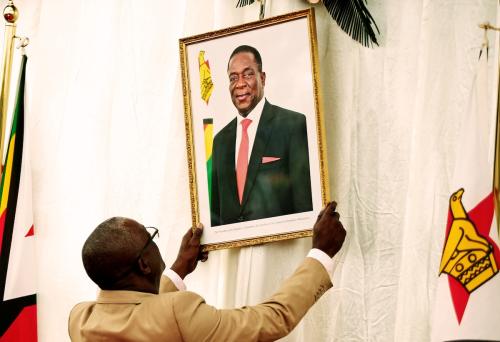

12:30 pm EDT - 2:00 pm EDT
Past Event
12:30 pm - 2:00 pm EDT
1775 Massachusetts Avenue, N.W.
Washington, DC
20036
The fourth session of the Iran Working Group, jointly organized by the Saban Center for Middle East Policy and the United States Institute of Peace, was held on July 10, 2008, at the Brookings Institution. The featured speakers were Iason Athanasiadis, a 2007-2008 Nieman Foundation for Journalism Fellow at Harvard University, and Dr. Djavad Salehi-Isfahani, Professor of Economics at Virginia Tech and Visiting Fellow at the Wolfensohn Center for Development at Brookings. They shared their expertise on the topic of the youth of Iran, a crucial demographic group between the ages of 15 and 29 that comprises more than one-third of the nation’s population. Young Iranians face bleak employment prospects and shifting family and cultural dynamics, posing a pressing political and economic challenge for their government.
The session began with a discussion of the background economic conditions in the Islamic Republic. It was noted that, in spite of widespread unhappiness expressed by the residents of Iran, the nation has experienced sustained growth over the past decade. In terms of expenditure, the size of the government has remained near constant or even decreased since the revolution, and the government has fostered respectable investment rates – currently more than 30% of GDP. In addition, poverty has been successfully reduced in recent years, falling to approximately the same rate as Turkey, a nation many Iranians look to as a model. One participant attributed the decrease in absolute poverty to rising oil prices and an abundance of construction jobs. That said, the government has notably failed in its oft-stated goal, present since the launch of the revolution, of decreasing the income gap between the rich and poor. Inequality as measured by the Gini coefficient has remained nearly constant in the range of 0.40-0.45.
Young Iranians have had a great deal of difficulty accessing the benefits of the past decade’s economic growth. In particular, they have been most adversely affected by the persistent unemployment in Iran. The youth have made great strides in education – most urban males and females have at least a high school diploma, and even rural females, long held back by the constraints of their more traditional lifestyles, now typically attain at least some high school education. However, they have faced difficulty upon leaving school. The length of the gap youths face between leaving school and beginning their first job grows with the amount of education attained, as jobs requiring advanced skills are not readily attainable for young Iranians. Data from 2005 show that while 90% of men have left school by age 23, it is not until age 29 that a corresponding percentage of men have found employment. The situation for young women appears bleaker – while their levels of educational attainment do not differ greatly from those of their male counterparts, the same data set shows that even by their late 20s, only 20% of them are employed. In what one participant suggested was tied to a psychological “bewilderment” effect among women caused by the rules of the regime, many of the women who are unable to find work decide to call themselves “homemakers” and effectively deny their interest in seeking employment – but even these aside, the unemployment rate among young Iranian women remains at approximately 50%.
The problem of youth unemployment is exacerbated by the sheer demographic challenge posed by the generation. While mortality rates have steadily decreased, the period immediately following the Islamic Revolution saw an enormous baby boom, spurred by the ideologically motivated closure of the Pahlavi-era family planning programs. When the extent of the demographic bulge eventually forced the government to reopen the programs, this move had surprising success – resulting in the current concentration of Iran’s population among those between 15 and 30 years of age.
The demographic shift in Iran has also affected the formation of families. With so many under the age of 30 excluded from viable employment and thus from ownership, particularly given the high price of real estate in today’s Iran, marriage has been taking place at later ages. In 1989, approximately 20% of men falling within the typical marrying age range of 25-29 had never been married, while by the early part of this decade, this proportion had risen to 40%. Similarly, the percentage of never-married women in this age group, which was traditionally later than the peak marriage age for females, rose from less than 10% in the mid-1980s to more than 25% after the turn of the 21st century. One participant connected this trend to reduced feelings of independence among youth and the “psychological pain” of not being able to form a family of their own, as now more than 70% of men in their 20s live with their parents, up from less than 50% in the mid-1980s, while the corresponding figure for women has risen from 20% to nearly 50%.
Solutions to such exclusion of youth from fully integrating into society must clearly address their unemployment levels. However, recent policies have failed in this regard. As one participant posited, former President Mohammad Khatami believed that “kindness” would solve the problems of the youth, and directed his attention toward opening up civic space and fostering greater liberty in Iran, hoping that this would trigger a more dynamic and entrepreneurial nation. Meanwhile, during the course of the current administration, President Mahmoud Ahmadinejad has focused more on his constituent base – the poor – when addressing the difficulties facing the youth of the nation. He has appealed his policies directly to the young of the lower classes via such state-tied organizations as the Basij, which have massive outreach programs among the poorer urban districts. However, while attracting somewhat of a social base for the government, this policy does little to address the fundamental economic hardships of Iran’s youth. Further, as one participant noted, for a candidate who ran on an anti-corruption platform, Ahmadinejad has had little noticeable effect on the prevalence of corruption in the government and economy.
One participant remarked on the social aspects of the exclusion of youth in Iranian society, implying that the young have turned to various methods of public expression partially as a reaction to their inability to fully integrate into societal institutions. Anecdotal examples of the sometimes-raucous street celebrations that take place on the holiday of chahar-shanbeh souri as well as the flouting of the Islamic behavior rules that takes place in popular social spots, particularly trendier upper-class hangouts and the outdoor teahouses and restaurants in the foothills of the northern outskirts of Tehran, were given as evidence of youth expression. In addition, it was noted that in spite of recent police crackdowns on dress code violations and behavioral transgressions such as public displays of affection, the authorities have had little to no success quelling such expression.
Youth expression in favor of the government has been seen in often ostentatious displays. Massive parades rife with Islamic revolutionary fervor and anti-Western themes, such as on the annual 22 Bahman (February 11) commemoration of the victory of the revolution, include great numbers of schoolchildren and teenagers and young adults from organizations such as the Basij. However, it was noted that the ability of the ruling regime to appropriate public space for its own public manifestations is what primarily allows for such grand displays.
Religious identity has remained important among much of Iran’s youth, but this spirituality is being channeled in different ways. While a contrarian streak has led many young people to move toward Sufism or even convert to Christianity, there remains sizeable youth participation in more traditional expressions, like the rituals of Moharram that ostentatiously commemorate the martyrdom of Imam Hussein, with major ceremonies often held by pro-government organizations like the Basij. However, one participant argued that the stereotype of the participants in such activities being committed to anti-Western ideologies can be misleading, noting photographs of youngsters engaged in Ashura ceremonies at Hosseiniyehs while wearing trendy European or American clothing.
On the importance of public intellectuals to young people and their concerns, two participants noted that intellectuals currently have limited influence relative to their role in the past. One argued that the most prominent reformist and liberal intellectuals, such as the dissident journalist Akbar Ganji, have ignored crucial issues of job creation, seeking instead to fight corruption and all those associated with it. The attacks of such figures as Ganji on former President Ali Akbar Hashemi Rafsanjani for his ties to corruption helped to erode his public appeal, even though he has been one of the only elite Iranian politicians seeking to reform the nation’s economy. Overall, an overreliance on socialist rhetoric and reverence of idealized historical figures like Mohammad Mossadegh may be serving to make prominent intellectuals significantly less relevant to the problems facing Iran’s youth than in years past. Another participant agreed but noted that, for the segment of the youth that ascribes to more pro-regime militaristic views, the public ideologues of groups like the Revolutionary Guards hold some influence via disseminated videotaped sermons.
Exhibiting a mix of personal and cultural frustration and economic discontent, the youth of Iran would seem to present a foreign policy opportunity to the US and its allies at a time when they are wishing for the opponents of the Islamic Republic’s hardliners to be emboldened. However, one participant posited that many young Iranians exhibit ambivalent reactions vis-à-vis the West, the product of a dichotomy between widespread admiration for Western culture and frequent disdain for the policies of American and European governments. One of the reasons for the muted nature of their enthusiasm has been American intervention in the Middle East. This leads some to conclude that the best possible action for Western nations seeking the admiration of young Iranians is currently political inaction.
The consequences of such a hands-off approach are unclear. One participant asserted that the benefit of the doubt seems to fall in favor of the average Iranian citizens who wish to create families and foster opportunity for their children eventually defeating the militaristic elements who can be seen as still fighting the battles of the 1980s. This could eventually shift policies to focus more directly on job creation, which would ultimately benefit the youth. However, such a transformation of the nation’s priorities will require policies such as greater private sector investment and labor market reform – prescriptions championed by only a few of Iran’s elite tier of politicians, such as Hashemi Rafsanjani – and cannot be expected to develop organically. But while a noninterventionist approach may thus seem unattractive to the West, development projects of external origin would be fraught with complications and likely unfeasible. As one participant argued, it may take only a critical mass of complaints by the Iranian people to succeed in transforming the labor market into a dynamic entity with the potential to alter the tide of economic hardship and disillusionment afflicting young Iranians.
12:30 pm - 2:00 pm
The fourth session of the Iran Working Group was held on July 10, 2008, at the Brookings Institution. The featured speakers were Iason Athanasiadis and Dr. Djavad Salehi-Isfahani. They shared their expertise on the topic of the youth of Iran, a crucial demographic group between the ages of 15 and 29 that comprises more than one-third of the nation’s population.

Rosanne Haggerty, Ruby Bolaria Shifrin, Jacob Taylor, Kershlin Krishna, Sara Bronin, Nick Cain, Xiomara Cisneros, Adam Ruege, Henri Hammond-Paul, Jamie Rife, Josh Humphries, Beth Noveck
October 27, 2025

Chipo Dendere, Miles Tendi
October 27, 2025

Caren Grown, Jerome De Henau, Laura Martinez, Ipek Ilkkaracan
October 27, 2025